Promoting the art and craft of lighting
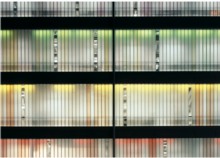
Both external and internal lighting of the Saltaire Centre at Glasgow Caledonian University so impressed the judges of the Lighting Design Awards that it won the category for workplace lighting, (Photo: Keith Hunter)
It is, perhaps, easier to appreciate good design than to understand it. The annual Lighting Design Awards provide that critical insight.While the latest Building Regulations and, indeed, many engineers place much importance on the efficiency of lighting, buildings would be uninspiring places in which to work, live and spend leisure if design were not also taken into consideration. One of the key roles of the Lighting Design Awards is to acknowledge outstanding design in lighting and also to give due recognition to developments in luminaires, light sources and control equipment. Demonstrating that workplace lighting can be more than just function is the Saltaire Centre at Glasgow Caledonian University, which won the category for workplace lighting. This educational establishment is the focal point for 15 000 students. The brief was to create a landmark, 1800-seat building as the hub for the campus. Internally the atrium is lit by projectors and mirrors, with 3-circuit lighting track in the main learning space for flexibility. A relaxed and informal space has been created towards the south of the building in the 2-storey concourse exhibition space and entrance, with asymmetric luminaires to distribute light into the main space. This lighting is supplemented with wall washing from high level onto the walls. All equipment is designed to be mounted in pairs on a theatrical-style boom with integrated emergency-lighting packs where required. Exterior lighting treatments include washing light downward onto the partially coloured Reglit wall to the north, which can be seen form the nearby motorway. The tower to the north is illuminated with ceramic metal halides, colour-sleeved linear fluorescent lamps and continuous LED flexible rope light. Lighting design for the Saltaire Centre was by BDP Lighting, and the M&E engineer was Hulley & Kirkwood. Equipment was supplied by Concord:marlin, Fagerhult, Louis Poulsen, Pulsar Light of Cambridge, Sill Lighting, Thorn, Wila and Zumtobel. There were two highly commended entries for workplace lighting — Hammerson’s head office in London and the Palestra office block, also in London. In Hammerson’s head office, public areas are lit with crisp linear slots spanning the ceiling of the first floor and the open void in the double-height reception using CDMs for a punchy, clean light and tungsten halogen for warmth. Cold-cathode lamps highlight sculptural forms in the reception and staff restaurant. Four meeting rooms visible from the atrium are lit in white, with Hammerson’s corporate pink and blue splashed from the shades. Lighting design for Hammerson’s head office was by Lighting Design International. Equipment was supplied by Artemide, Delta Light, Erco, Modular Lighting and Oldham Lighting. Also commended in the category for workplace lighting was the Palestra office block in London. This spectacular office block above Southwark underground station is illuminated by blue LEDs and internal coloured fluorescent lighting at night to retain its imposing image after dark. The building canopy creates an open plaza below, and lighting helps to draw visitors to the reception, with its large circular ceiling cones lit with concealed cold-cathode lamps to create a visual link from outside to inside. Lighting design for Palestra was Pinniger & Partners. Equipment was supplied by Crescent Lighting, Erco, Neolec Lighting and Norka Lighting.
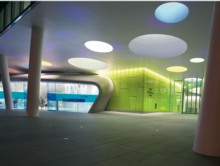 |
| — Contributing to the spectacular impression created by the Palestra building in London is its lighting. (Photo: Alan Russell, Zed Photography) |
Away from the need to combine functionality and aesthetics in the workplace, the lighting-for leisure category gives full rein for designers to demonstrate their creativity. Unless you are a regular traveller with Virgin Atlantic, and paying the top fares, you are unlikely ever to see the winner of the category lighting for leisure — Virgin Atlantic’s Upper Class Lounge at Heathrow.
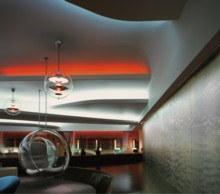 |
| — Dramatic lighting effects in Virgin Atlantic’s Upper Class Lounge at Heathrow won the category Lighting for Leisure. (Photo: Richard Davies) |
This spectacular 2500 m2 clubhouse includes a spa, restaurant and bar — with interiors that feel like a private members’ club. Despite a multitude of services and facilities, the clubhouse has been kept as open as possible — and the lighting design had to provide full legibility of the scheme’s complexity while indicating individual areas in a unified manner. The judges felt that it ‘overcame restricted space to create a sophisticated environment with lighting that is integral to the design concept’. The sweeping ceiling is fully rendered to recall an expanse of sky, where subtle shifts in lighting hue provide atmospheric raking. High-output cool cold cathode, combined with low-voltage linear tungsten lighting, allows a variety of bright, fresh lighting during the day and warm dimmed lighting in the evening to create an intimate space. Some touches of blue, orange and purple at the edges mimic a summer-day horizon, sunset and midnight colours. All lighting is concealed in furniture and architectural details, while the main ambient lighting comes from the artificial sky. Lighting design for the Virgin lounge was by Isometrix Lighting + Design. The cold cathode lighting was supplied by Oldham Lighting. While clearly having function, but as far from purely functional lighting as you could be, is the commended entry in the category lighting for leisure — the Cuckoo Club in London. The client wanted a glamorous lighting scheme to reflect the glamour of this new-launch West End club. The scheme uses bespoke lighting features, details and fittings for flexibility and to allow multiple uses of the space. Features include diamond-pattern colour-change LEDs, a 1.5 m-diameter rotating mirror ball in a giant purple silk lampshade and ceiling-mounted panels incorporating more colour-change LEDs. Programmed scenes provide everything from a colourful backdrop for the club to different scenes for events and promotions. Lighting design for the Cuckoo Club was by Blacksheep, Into Lighting. Equipment was supplied by Artistic Licence, Enigma Lighting, iVision and Mode Lighting. Designing and delivering lighting schemes requires equipment such as luminaires, lamps and control gear — and they have their own categories in the Lighting Design Awards.
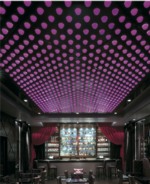 |
| — Lighting for effect — the Cuckoo Club in London. (Photo: Edmund Sumner) |
The category for interior luminaires was won by Novaluna S. Siteco Lighting with a suspended luminaire incorporating the latest evolution Eldacon micro-prismatic material that allows high levels of luminance without glare. Designers can therefore use this product when considering ergonomic and flexible lighting for workspaces. These latest Novaluna luminaires create light all round by the increased use of transparent materials, minimal design and a depth of only 32 mm. Its ballast components allow the use of lamps of different wattages in the same product. The judges called it a ‘little piece of perfection’ and a ‘great piece of industrial design. Although they dubbed it ‘evolutionary rather than revolutionary, they concluded that it does its job beautifully and is a superb balance of engineering and aesthetics’. Designers are constantly faced with the problem of integrating emergency lighting into schemes, and the judges of the Lighting Design Awards described Concord:marlin’s LED emergency-lighting system as using ‘LEDs for what they are good at now rather than what we’d like them to be. Based on two 1 W LEDs, these emergency modules can be integrated into existing lighting components or can simply be added to Concord:marlin track. At 3 m mounting heights and recommended spacing, the LEDs produce 1 lx on the floor. Another significant step forward in the development of LED arrays was the Titan’s LED Light Engine from Lamina Ceramics. This development allows LEDs to be plugged in rather than soldered into products. Titan has a beam angle of 60°, enabling designers to make low-profile fittings, and can deliver over 1400 lm of ‘daylight white’ or 600 lm of halogen-like CRI light. For applications where multiple colours are needed, Lamina also offers an RGB version.
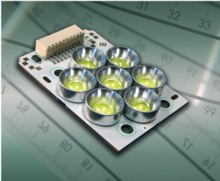 |
| — LED arrays developed by Lamina Ceramics can be plugged into products, rather than soldered, and deliver high light outputs. |
Another acclaimed light source was the ConstantColor CMH SuperMini from GE Consumer & Industrial. This range of products is based on a ceramic arc tube construction that has enabled GE to develop a metal-halide source that is efficient, reliable and extremely small. These features should make possible very efficient luminaire design. A 20 W SuperMini lamp is similar in size to a tungsten capsule and provides 1615 lumens with a life of 12 000 h. The judges liked ‘the precision and neatness, combined with great performance’. They especially commended the PAR version. It is often said that lighting in buildings that is more than five years old should be replaced on energy-efficiency grounds. With the kinds of developments thrown up each year by the Lighting Design Awards, that principle does not seem overstated.
Related links:
Related articles:












